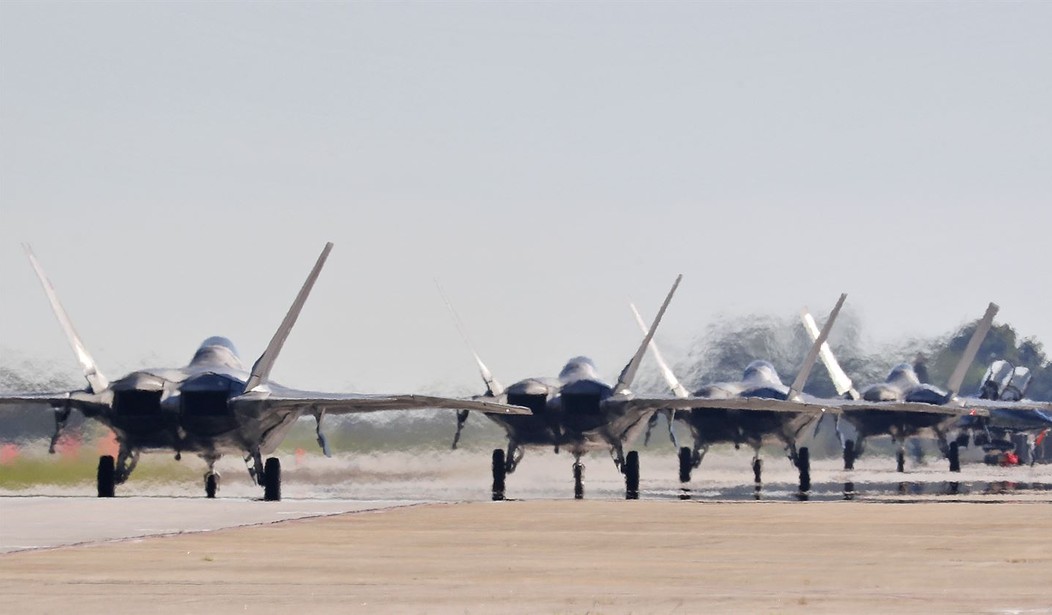Sometimes, I wonder whether the Pentagon is the biggest danger to America's military.
Perhaps that is a bit harsh--after all, by sheer chance, all those bureaucrats must accomplish something good. And to a certain extent, wasted money is the cost of doing business in the military--efficiency of the type you see in corporations is often anathema to resilience, which theoretically is vital when you are talking about hardware that is subject to attrition and use by people of varying skill and ability.
But recent history suggests that the procurement process at the Pentagon is so broken that tens of billions of dollars are thrown down the garbage disposal and important capabilities are never realized.
The latest example is the potential cancellation of the Next Generation Air Dominance aircraft, which recent reports suggest is in deep trouble and may be on the chopping block.
In recent years those of us who are military geeks have been following the development of the NGAD, and the news out of the military (which is always puffed up) has been especially good. The program was supposed to be a model of efficiency due to its being designed and tested digitally, and we have been promised world-changing capabilities that would put the F-22 to shame.
The NGAD aircraft is envisioned as a long-range crewed fighter jet equipped with advanced sensors and weapons payloads designed to operate in highly contested environments in the Indo-Pacific, where China is seen as the top military threat to U.S. forces. Considered a replacement for the fifth-generation F-22 Raptor, NGAD’s main mission will be to establish air superiority.
Fielding a new air-superiority fighter for future operations is paramount, said Michael Bohnert, engineer and analyst at the RAND Corp. The Lockheed Martin-made F-22 has been in service for two decades, and the Air Force has requested to retire older Raptors — of which there are only 186 in operation — in its last few annual budget requests to Congress.
“There needs to be a replacement for the F-22, and the [F-35 Lightning] is not it,” Bohnert said in an interview. “The F-35 is a strike fighter, the F-22 is an air-superiority fighter. That is something you need to counter adversary bombers, heavier fighters, etc. It’s a mission set that you need something more like the follow-on to an F-22 to do.”
Although NGAD is a highly classified program, it’s thought that the platform will have improved stealth, significantly longer ranges and larger weapons, according to Mark Gunzinger, director of future aerospace concepts and capabilities assessments at the Mitchell Institute.
Nobody was claiming that capability would come cheap--rumors were that the cost per unit would be about $300 million, but that is about what an F-14 cost in 2024 dollars, so while mind-boggling the cost would not be unprecedented. The capabilities were supposed to make the investment worth it, as the NGAD wasn't supposed to be another aircraft but the key node in a system that would include autonomous aircraft that could increase capabilities and especially survival.
Opinion: It's time to explore alternative design and acquisition strategies to significantly reduce the cost of NGAD and expedite its delivery. https://t.co/alpqiHC5Sg
— Defense News (@defense_news) June 26, 2024
So little concrete information is out there that I won't pretend to know whether there is some chink in NGAD's armor that justifies tossing years of work out the window, but if NGAD does get canceled, it would be the next failed modernization project in a long line of expensive duds.
The Army's Future Combat System--another program driven by the promise of networked capabilities--sucked up billions of dollars and ended with a whimper. The F-35, while we are told it is a very capable aircraft, is plagued by so many problems and delays that sometimes you have to wonder why they didn't cancel that program.
Then you have the Ford-class aircraft carriers. Someday they may prove their mettle, but that day is not now.
And, of course, the F-35 was supposed to be the "low" in the Air Force's "High/Low" strategy, with a more capable air dominance fighter (which is now the F-22 and was to be the NGAD) taking the lead in establishing air supremacy.
The F-22 itself is widely acknowledged to be the best fighter aircraft in the world despite being rather long in the tooth. However, the Bush Administration cut the program far short of the intended 750 aircraft, and there are fewer than 200 in the arsenal--not enough for a near-peer conflict and the attrition we should expect. Restarting the production of the F-22 would cost as much as producing the NGAD, so that is a non-starter.
Until recently, NGAD was thought to be on schedule to be fielded sometime in the 2030s. The Air Force announced last year that it intended to pick a prime contractor for the aircraft in 2024, with Lockheed Martin and Boeing widely considered to be the two main vendors vying for the program.
However, on June 13 Air Force Chief of Staff Gen. David Allvin hinted the service might be reevaluating plans due to funding constraints. He later told reporters during a June 14 briefing that “deliberations are still underway” and that the department is “looking at a lot of very difficult options that we have to consider.”
The Air Force initially began NGAD concept studies with the Defense Advanced Research Projects Agency in 2014, later expanding its scope to include an entire family of systems comprising loyal wingman drones known as collaborative combat aircraft (CCA) and advanced command-and-control technologies.
No doubt the NGAD, should it be built, will be an imperfect fit to the requirements of the next war, and some in the Air Force are saying that they should reconsider the requirements for the next air dominance fighter.
Yes, but...you don't go to war with the military you optimally need; you go to war with the military you have, and we keep putting off investing in the military we have in hopes that some magic bullet will come along to fill every niche.
If the US had built the 750 F-22s originally planned, it would have been easier to increase their individual lifespans--with fewer aircraft, you fly each one more and rack up the hours more quickly. And, if the range of the F-22 were longer, as the NGAD's was supposed to be, chances are that the F-22's capabilities would be more than a match for adversaries. Not only are the aircraft superb, but our pilots are also the best in the world.
But dropping the NGAD means putting off modernization for another decade or more, and in 10 years the mirage of an even more capable aircraft will arise. You have to commit some time.
Ultimately the problem here isn't that any one weapons platform has been starcrossed; it's that every weapons platform development process has been. This gets us to the Pentagon, which needs a new model for how to develop, produce, maintain, and deploy whatever it decides to use.
The Pentagon has what seems to be the same disease as NASA, United Launch Alliance, and Boeing have. The project management is atrocious. Things go too slowly, the quality control is lacking, the cost overruns are unbelievably high, and the results are disappointing. Over-promised, under-delivered, at 4x the cost.
I hate to beat the drum for the SpaceX development model because it gets tiresome, but the company delivers. Later than Elon Musk promises, but Musk promises the impossible and then only delivers a miracle. Boeing can't even deliver a safe 737 anymore.
Does America NEED this version of the NGAD right now?
I couldn't say. Obviously, we need a plan to deliver a massively more capable fighter sometime in the next decade or so, but I can't say if choosing this fighter right now is necessary or not.
What I do know is that we need a process we can rely on to make these decisions, develop the project, deliver it relatively on time and budget, and maintain it over its lifetime in a rational manner that meets our potential military needs. The more and better capabilities we have the less chance that we will need to use them.
What needs fixing right now is the process. We can't afford more fiascos. Let's hope the NGAD does not become the next in a long list of them.







Join the conversation as a VIP Member